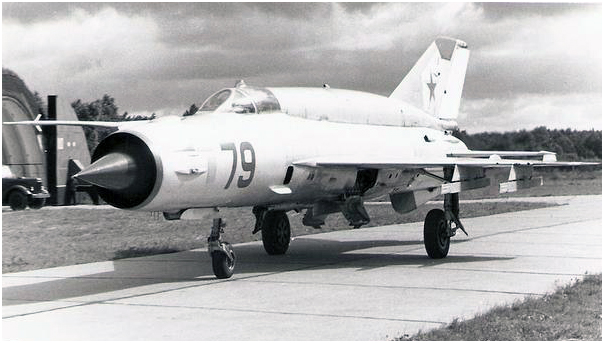
 Bill Burhans served as a tour officer with the USMLM Air Team from July 1971 to June 1975. He returned in 1979 to command Detachment 16,
7113th Special Activities Squadron (the Air Team), departing in early spring 1980 following a December 1979 Soviet-originated nasty incident.
He remembers for us a MiG-21SMT hunt at Wittstock that ended unexpectedly in a potato field.
Bill Burhans served as a tour officer with the USMLM Air Team from July 1971 to June 1975. He returned in 1979 to command Detachment 16,
7113th Special Activities Squadron (the Air Team), departing in early spring 1980 following a December 1979 Soviet-originated nasty incident.
He remembers for us a MiG-21SMT hunt at Wittstock that ended unexpectedly in a potato field.
I don't remember now why the Air Team reconnaissance tour NCO was unavailable for this scheduled tour, but I was assigned an Army driver. To make things even more complex, this driver also happened to be the Potsdam House Father. Perhaps the idea was to familiarize him with what tour personnel encountered out in the zone, but the fact remained Staff Sergeant Johann Schniedermeier, who was very inexperienced, was my driver for this trip into Area A (northern part of East Germany). We departed the Potsdam House during darkness and headed north up Route 2. Our first task was to do an inventory check at the Wittstock-Biesen Radar Site (1), following which we would find a pre-OP and hope the Wittstock Airfield MiG-21 FISHBED K aircraft from the 33rd Fighter Aviation Regiment would engage in flying operations. We made our way to Herzberg, where we turned north towards Wittstock. When we reached Lelichow, we followed field trails to Königsberg, then on to the small village of Papenbruch, continuing along field trails until we reached Jabel.
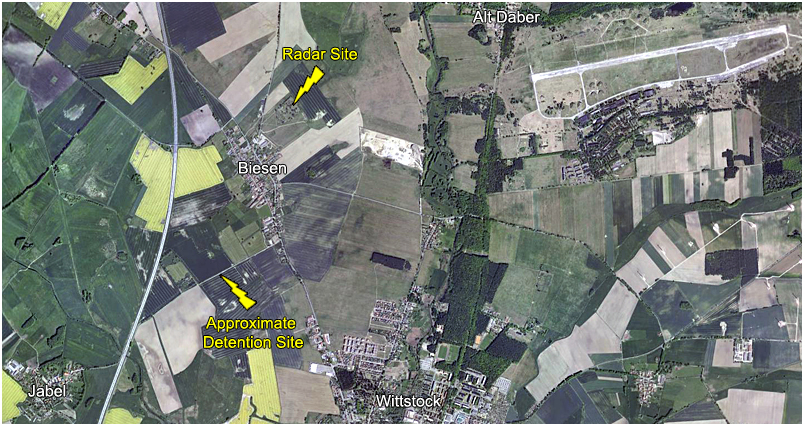
It was very early in the morning on November 22, 1972. I was not concerned when we passed through this tiny village southwest of the radar site. I thought I saw the curtains move in the window of one of the houses as we passed by, but I paid little or no attention to this. It was still dark and there was no discernible activity so I decided we would stop under the cover of a large tree alongside a field trail running between the village of Jabel and the hard-surfaced road connecting Biesen and Wittstock. I should point out here that Highway E55/19, the autobahn on the left side of the picture above, had not been built at this time. I did not intend to stay in the area very long. Due to the slight drizzle and fog, I could barely make out the radar site on the hill about 1 ¼ miles away, so we had ourselves a cup of coffee while we waited for sufficient light to permit us to check the radar site equipment. I imagine we were there for about 30 minutes. It was very quiet around us, the weather was pretty bad and, although there were very low clouds and a pretty stiff wind, there was no steady rain yet. Not the best conditions for flying so I thought it would probably be best to just skip the airfield pre-OP and revert to the targets on our list of alternates.
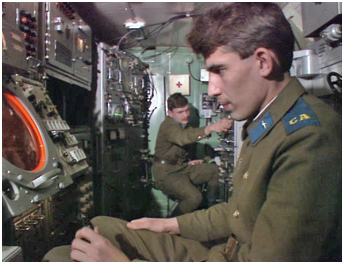 Vue de l'intérieur de la cabine des opérateurs du radar P-18 "Spoon Rest D" du site de contrôle de la chasse à
Wittstock-Biesen. © MiG-29 über Deutschland.
Vue de l'intérieur de la cabine des opérateurs du radar P-18 "Spoon Rest D" du site de contrôle de la chasse à
Wittstock-Biesen. © MiG-29 über Deutschland.
The operators' cabin of the P-18 "Spoon Rest D" radar of the fighter control unit from
Wittstock-Biesen. © MiG-29 über Deutschland.
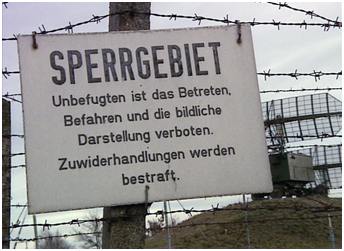 Le site radar de Wittstock-Biesen en 1990. On peut voir en arrière-plan un radar P-37 "Barlock-B"
de recherche et d'acquisition. © MiG-29 über Deutschland.
Le site radar de Wittstock-Biesen en 1990. On peut voir en arrière-plan un radar P-37 "Barlock-B"
de recherche et d'acquisition. © MiG-29 über Deutschland.
The Wittstock-Biesen radar site in 1990. One can see in the background a P-37 "Barlock-B"
search and acquisition radar. © MiG-29 über Deutschland.
It came time to finally get on the move and head for the hard-surface road that ran past the radar site.
We pulled out onto the field trail and headed for Biesen. When we were about 300 yards from the edge of
Biesen, I noticed a parked Zil-130 canvas-topped truck with a GSFG roundel on the doors (2)
and a typical six-element vehicle registration number (VRN)
driven by a soldier with blue tabs indicating subordination to a Soviet VVS entity.
This did not look right, so I told Johann to stop and begin backing up towards
Jabel behind us.
When he looked over his shoulder and began to back up, Johann saw a military vehicle there as well.
Not good! We were in a very bad position, because there was a single-strand wire fence encircling the
potato fields, along with a shallow ditch, on each side of us. At this point, it seemed best to stop backing
up and to head for Biesen again, hit the paved road and depart the area.
As we approached the town, the cargo truck started moving in the middle of the field trail right
towards us. Schniedermeier asked me what he should do. I told him to keep going straight, try to give the
Soviet driver a "head fake," hit the potato field at as fast a rate of speed he could possibly attain and then
make a dash around the truck. (This element of the situation was new to me. An Air Team reconnaissance
NCO did not need to be told what to do. He instinctively reacted to each developing situation.)
Johann accomplished only part of his instructions. He headed for the Soviet truck and then swung the
vehicle left into the potato field. However, he did so before he had attained sufficient speed. So, when he
hit the field, we immediately began to bog down. He was unable to extricate us so we ended up buried in
the potatoes...
 L'emblème symbolisant le GFSA qui apparut sur les véhicules à roue à partir de 1970.
L'emblème symbolisant le GFSA qui apparut sur les véhicules à roue à partir de 1970.
The badge relative to the GSFG that appearted on the wheeled vehicles from 1970 on.
 Le Groupe des Forces Ouest dont les initiales en Russe étaient "ZGV" succéda au Groupe des Forces Soviétiques en Allemagne le 1er juin 1989. Mais c'est la chute de l'URSS
qui fut le catalyseur amenant à la création d'un nouveau badge orné du drapeau russe. Ce dernier, désormais dépourvu de l'étoile rouge et de la
mention "CA" pour Sovietskaya Armiya remplaça l'ancien emblème à partir de la mi-1992.
Le Groupe des Forces Ouest dont les initiales en Russe étaient "ZGV" succéda au Groupe des Forces Soviétiques en Allemagne le 1er juin 1989. Mais c'est la chute de l'URSS
qui fut le catalyseur amenant à la création d'un nouveau badge orné du drapeau russe. Ce dernier, désormais dépourvu de l'étoile rouge et de la
mention "CA" pour Sovietskaya Armiya remplaça l'ancien emblème à partir de la mi-1992.
The Western Group of Forces whose initials in Russian were "ZGV", succeeded to the Group of Soviet Forces in Germany on 1st
June 1989. But it is the collapse of the USSR that led to the creation of a new badge decorated with the Russian flag. The latter, now devoid of the red star and the
"CA" mention for Sovietskaya Armiya replaced the old logo from mid-1992 on.
A half-dozen armed Soviet Military Air Forces (VVS) troops immediately jumped out of the truck
and surrounded the vehicle. A VVS captain pounded on the window and demanded our documents. I tried
to ignore him, but he was persistent. I handed over my pass to him. As he examined my pass, I began to
think this would not be too serious.
However, things began to look a bit worse when he then asked for
Schniedermeier's pass. He examined this document, then turned back to me to request the car pass. At
this point, I knew that we would be there for a while!
I was not terribly experienced myself and admittedly was quite uncomfortable. I had been briefed on
what happened during a detention, but that information was only valid for the individual case being
described. Each situation differed, because the geographical area differed. More importantly, the Soviet
players differed and that introduced some wild cards. I finally got out of the vehicle and tried to chat with
the young Soviet officer. It turned out he was just about as nervous and uncertain as I was. He did not
want to communicate with me other than to tell me someone from the komendatura was en route to sort
things out.
Finally, a Soviet jeep arrived bearing a very portly red-faced Soviet Army officer, a lieutenant colonel
wearing motorized infantry insignia.
He introduced himself as Bazanov, the Wittstock kommendant. He
was in a very good mood and jokingly asked why we had chosen to try to plow up the peoples' potatoes!
He said we were in real trouble as we had damaged the crop, knocked down a fence, were in a restricted
area, had been observing and photographing military equipment and so forth. I denied everything, of
course. He said it would be necessary for us to accompany him to his office in the city of Wittstock. He
added that he would be happy to have the young lads help push our car out of the potato field.
The column formed up - Lieutenant Colonel Bazanov in his jeep, the tour car carrying the interlopers and the ZiL-130 cargo truck - and then made a right-hand turn onto the hard-surfaced road leading from Biesen into Wittstock, where we proceeded through the city. Along the way we noticed the engine of the vehicle was beginning to heat up. Apparently we had put a small hole in the radiator when we hit the potato field.
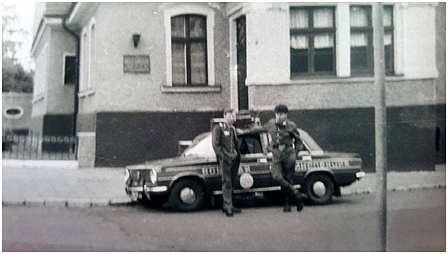 Deux militaires prennent la pause à côté de leur VAZ-2101 "Jigouli" aux couleurs de la Voennaya Komendatoura, parquée devant le bâtiment du commandant militaire
de Wittstock. © G.Anikine.
Deux militaires prennent la pause à côté de leur VAZ-2101 "Jigouli" aux couleurs de la Voennaya Komendatoura, parquée devant le bâtiment du commandant militaire
de Wittstock. © G.Anikine.
This VAZ-2101 "Zhiguli" of the Voennaya Komendatura was parked in front of the military commander's office from Wittstock.
© G.Anikin.
When we got to the komendatura, Staff Sergeant Schniedermeier
remained in the locked tour car and I accompanied Bazanov and the VVS captain into the building.
The captain and I were left in a small room containing a table and several chairs. Bazanov went to his
nearby office to make the necessary phone calls. I could hear him shouting at the top of his lungs on the
phone trying to explain to someone at some headquarters what was going on. It was about 11 a.m. by this
time and it was to become a long boring day.
I finally had a good chance to talk with the young captain, who turned out to be quite a pleasant guy.
At first he complained a bit. He said he and his troops were en route into Wittstock to pick up rations for
his unit. He, his vehicle and his troops had been requisitioned for the detention operation. The rations
would not get to the radar site in time for lunch to be prepared, and he would obviously now have to
become embroiled in the waiting and the detention paperwork.
He had a multitude of questions for me about life in America, life in the US military, promotions, pay
scales and all such things. He also made the interesting comment that, since the weather was so bad, the
aircraft would not be flying anyway so we would not miss much. This continuing conversation did a great
deal to make the long wait for Bazanov palatable.
Bazanov finally called me into his office. He had prepared the akt, or statement, which enumerated all
the dastardly things this USMLM reconnaissance tour team had been doing there in his area of
responsibility. He asked me to please sign the document, which I naturally refused to do. He dutifully
made a hand-written notation on this typed document: "Captain Burhans refuses to sign the akt." He then
said he would call my driver in so he could sign the document. I told him Sergeant Schniedermeier also
would refuse to sign. He dutifully noted that as well: "Sergeant Schniedermeier refuses to sign the akt."
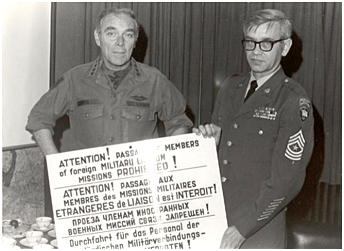 Le Sergent Major Bill Corbett remet une pancarte anti-missions au Général Alexander Haig, Commandant suprême allié en Europe
- SACEUR (1974-79), dans les locaux de la Mission à Berlin-Ouest. © USMLM.
Le Sergent Major Bill Corbett remet une pancarte anti-missions au Général Alexander Haig, Commandant suprême allié en Europe
- SACEUR (1974-79), dans les locaux de la Mission à Berlin-Ouest. © USMLM.
Sergeant Major Bill Corbett presenting General Alexander Haig, Supreme Allied Commander Europe - SACEUR (1974-79),
a mission restriction sign at the Mission House in West-Berlin. © USMLM.
I gleaned some interesting information during my few minutes in Bazanov's office. On the wall
behind his desk was a map of the Wittstock area reflecting the zone of responsibility of the Wittstock
komendatura. The permanently restricted area (PRA) was clearly marked in pink, but I noticed an area
marked in red that ran around the edge of the PRA boundaries. The area delineated extended the PRA out
some 3 kilometers and obviously represented a type of buffer zone. I surmised this was the area that was
marked off by the notorious mission restriction signs (MRS). It was clear the Soviet military
considered this to be a formally restricted area, which, by the way, included the location in which we
were detained.
However, none of the three allied military liaison missions recognized the validity of these MRS and ignored them. In
1971 and 1972, USMLM Ground Operations Officer Lieutenant Colonel Bob Von Dach even organized a
campaign to tear down these signs, the locations of which were carefully plotted on a special map. Each
reconnaissance tour that headed out into the zone during this campaign was tasked to bring back specific
MRS designated by map coordinates. Woe be it for any tour team that dared return to Berlin without
having harvested its assigned MRS!
At this point I figured this detention was over and we were about to be released. Wrong! I had
neglected to consider the fact that it was still daytime, that it still was light outside. The Soviet side
deemed it mandatory that we remain under detention until darkness to preclude any opportunity for
observation and photography. We finally were released late in the afternoon, after Lieutenant Colonel
Bazanov inquired if I would be able to find my way back to Potsdam in the dark!
We limped back to Potsdam without incident, other than periodically having to stop to fill the radiator
along the way...
notes
(1)
The unit based on that radar site was the 2196th Radar group (rlg) subordinated to the 314th Separate automatic control batallion (obAU).
It was the fighter control unit of the 33.IAP. The site elevation was 91.8 meters. In 1990, the equipments included a P-37 search and
acquisition radar, a P-18 early warning radar and a PRV-13 height-finding radar, among others. Associated mobile or deployable automatic contol systems
would have been located inside two AU-11-type HAS at Wittstock airbase itself.
(2) Here is what the USMLM Unit History report for 1970 mentioned
on page 15:
New National Markings
GSFG adopted new national markings for vehicular equipment during the first months of the year. The solid white roundel
previously used on the rear of vehicles was replaced by a roundel of similar size having the upper half painted white
and the lower half red. A small red star was centered in the upper portion of the roundel and Cyrillic letters "CA" (Soviet
Army) were painted in white in the lower portion. The symbol was also painted on the right and left front doors of
sedans and on the cab doors of vehicles so equipped. A small red star was added to the white field on the ends of front
bumpers on wheeled vehicles. A white star was added on each side of the turret of all armored vehicles so equipped and
on the sides of other armored vehicles.
 |
Plan du site - Sitemap |  |

